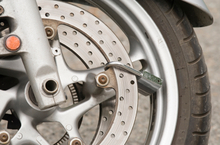

 I live in mortal fear of having my motorcycle stolen. Sure, I’ve got insurance, but I would never be able to recover the time and energy, blood, sweat and tears that I have invested in my ride. Not to mention the hassle, and the feeling of violation that accompanies a theft. I just don’t need it. So, I’ve been looking into different forms of motorcycle security.
I live in mortal fear of having my motorcycle stolen. Sure, I’ve got insurance, but I would never be able to recover the time and energy, blood, sweat and tears that I have invested in my ride. Not to mention the hassle, and the feeling of violation that accompanies a theft. I just don’t need it. So, I’ve been looking into different forms of motorcycle security.
The best security for your bike is parking it indoors in a secure garage or parking lot. If you can park indoors rather than on the street while you are on your motorcycle trip, do it. It’s hard to steal a bike that you can’t see.
Even if you do park indoors, you should take additional precautions. The most basic motorcycle security is a lock. Multiple locks are better than single locks. I always travel with a 6′ cable lock or a chain lock, long enough to go through my bike’s frame and wheel. If possible, I chain my bike to a big, stationary object, like a lamppost or mailbox. That way, a clever thief with a van and a hoist won’t be able to just throw my bike in their vehicle and drive away, dealing with the lock later.
In addition to a chain or cable lock, I also recommend using a disc lock. A disc lock is a very simple specialty lock that attaches to your bike’s front brake disc with a pin that goes through one of the holes in the disc, preventing the wheel from fully rotating. It’s nearly impossible to defeat a disc lock without the key — there’s just no room to get at the pin, and attacking the keyhole will just jam the mechanism. The great thing about a disc lock is that a good one is small, inexpensive and easy to use. The terrible thing about a disc lock is that it’s easy to forget that you’ve put one on, and trying to ride away without removing it will have embarrassing, possibly damaging consequences. Add in a rider warning cable that attaches to your handlebars in order to avoid a disaster.
Technology can also help out with motorcycle security. An aftermarket motorcycle alarm is a great investment, but step up from one that just makes noise to one that also immobilizes your bike when it senses tampering. Several companies also make alarm systems that will notify you with a text message when the alarm is activated, so that you can get back to your bike before thieves have a chance to take off.
The authorities recommend that you not confront motorcycle thieves in the act of stealing your bike — instead, observe and report. Pay attention to details, like clothing, height and build of the perpetrators, and call 911. That’s smart advice that I would probably have a hard time following, to be honest. But it’s the advice that I will pass along anyway.
Even with the best security, there’s still a chance that your bike might get stolen. If it is stolen, there’s very little chance that you’ll ever see your bike again. LoJack would like to change the odds in your favor with its Stolen Vehicle Recovery System. A sensor is installed on your motorcycle, and if it is stolen, the sensor is activated so that the police can track and recover the vehicle.
Like motorcycle insurance, motorcycle security is something that you hope you’ll never have to use. But it’s a reality, especially during motorcycle travel when you can’t always control where you’ll be parking your bike. Take a little bit of time to plan, and you can avoid a very unpleasant situation on the road.